Human Resource Management Report: Aldi's Workforce and HRM Strategies
VerifiedAdded on 2020/06/06
|12
|3778
|95
Report
AI Summary
This report provides a comprehensive analysis of Human Resource Management (HRM) practices within Aldi, a major grocery retailer. It begins with an introduction to HRM, emphasizing its significance in workforce planning and resourcing. The report then delves into the major purposes and functions of HRM, focusing on workforce planning in the context of Aldi, including the evaluation of current human resource requirements and the recruitment and selection processes. The report further examines the strengths and weaknesses of various recruitment approaches, comparing internal and external methods, and discusses the benefits of different HRM practices for both employers and employees, such as improved employee performance and motivation. It also evaluates the effectiveness of HRM practices in raising organizational profit and productivity, including training and development, performance management, human resource planning, and reward management. The importance of employee relations in influencing HRM decision-making is also highlighted, along with key elements of employment legislation and its impact on HRM. The report concludes with a discussion of HRM applications in a work-related context, supported by specific examples.
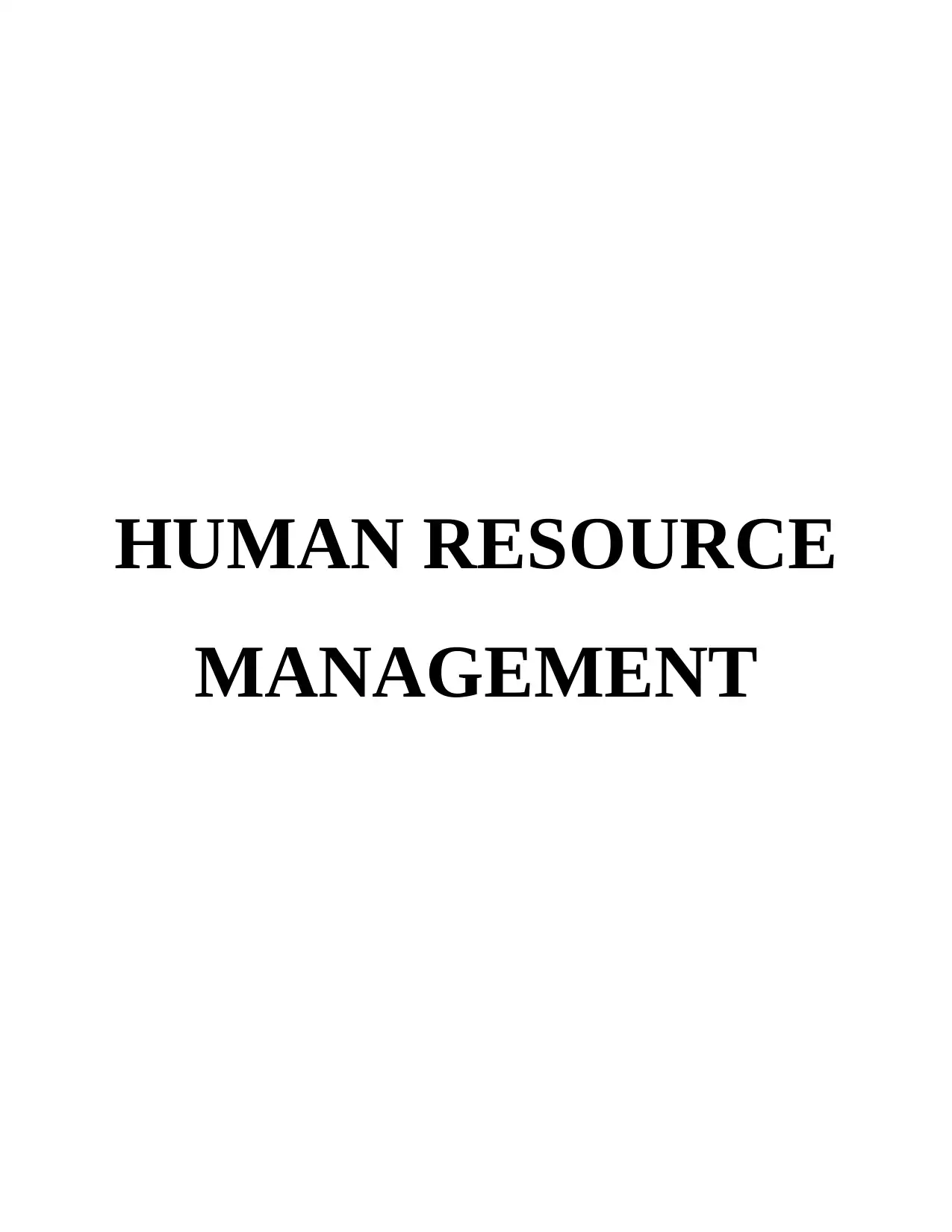
HUMAN RESOURCE
MANAGEMENT
MANAGEMENT
Paraphrase This Document
Need a fresh take? Get an instant paraphrase of this document with our AI Paraphraser
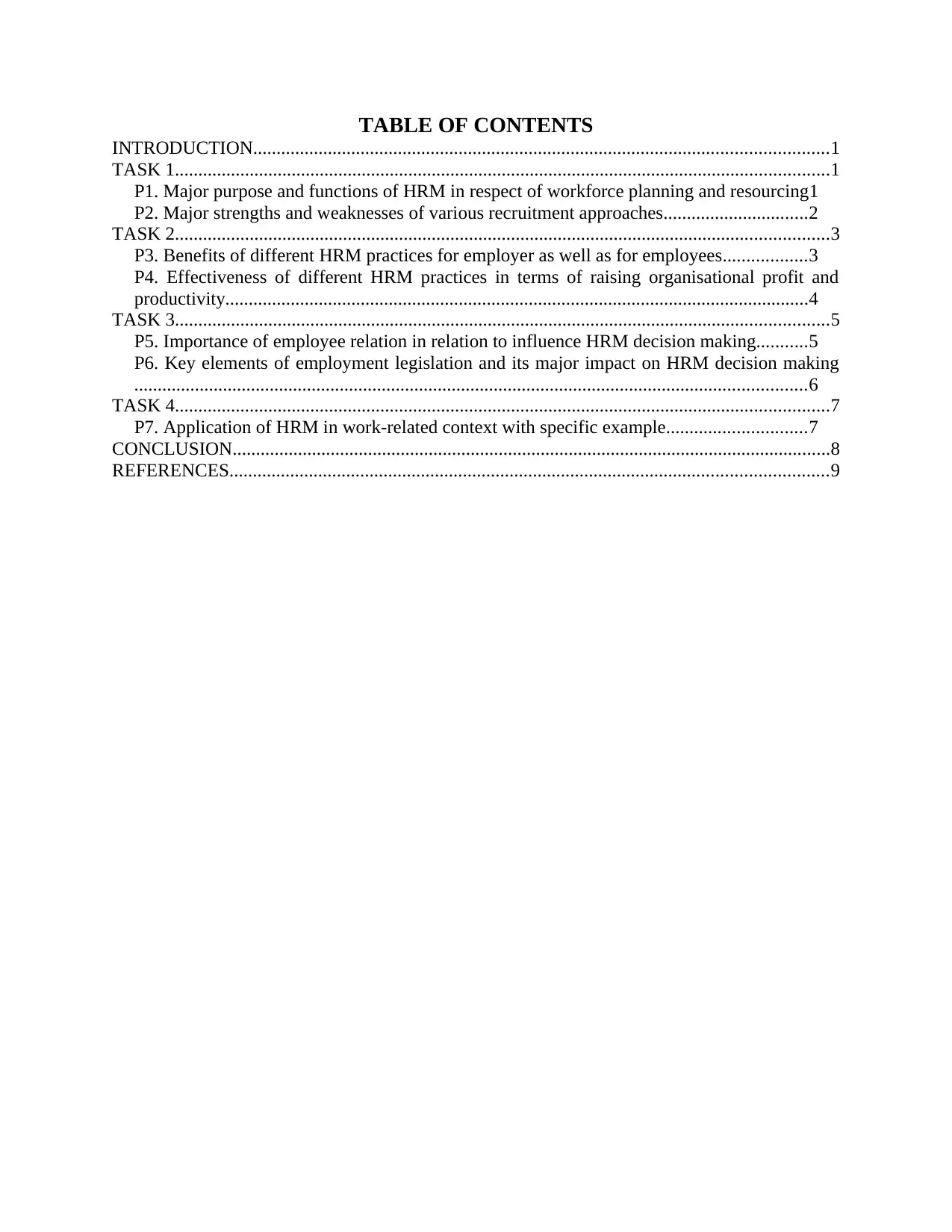
TABLE OF CONTENTS
INTRODUCTION...........................................................................................................................1
TASK 1............................................................................................................................................1
P1. Major purpose and functions of HRM in respect of workforce planning and resourcing1
P2. Major strengths and weaknesses of various recruitment approaches...............................2
TASK 2............................................................................................................................................3
P3. Benefits of different HRM practices for employer as well as for employees..................3
P4. Effectiveness of different HRM practices in terms of raising organisational profit and
productivity.............................................................................................................................4
TASK 3............................................................................................................................................5
P5. Importance of employee relation in relation to influence HRM decision making...........5
P6. Key elements of employment legislation and its major impact on HRM decision making
................................................................................................................................................6
TASK 4............................................................................................................................................7
P7. Application of HRM in work-related context with specific example..............................7
CONCLUSION................................................................................................................................8
REFERENCES................................................................................................................................9
INTRODUCTION...........................................................................................................................1
TASK 1............................................................................................................................................1
P1. Major purpose and functions of HRM in respect of workforce planning and resourcing1
P2. Major strengths and weaknesses of various recruitment approaches...............................2
TASK 2............................................................................................................................................3
P3. Benefits of different HRM practices for employer as well as for employees..................3
P4. Effectiveness of different HRM practices in terms of raising organisational profit and
productivity.............................................................................................................................4
TASK 3............................................................................................................................................5
P5. Importance of employee relation in relation to influence HRM decision making...........5
P6. Key elements of employment legislation and its major impact on HRM decision making
................................................................................................................................................6
TASK 4............................................................................................................................................7
P7. Application of HRM in work-related context with specific example..............................7
CONCLUSION................................................................................................................................8
REFERENCES................................................................................................................................9
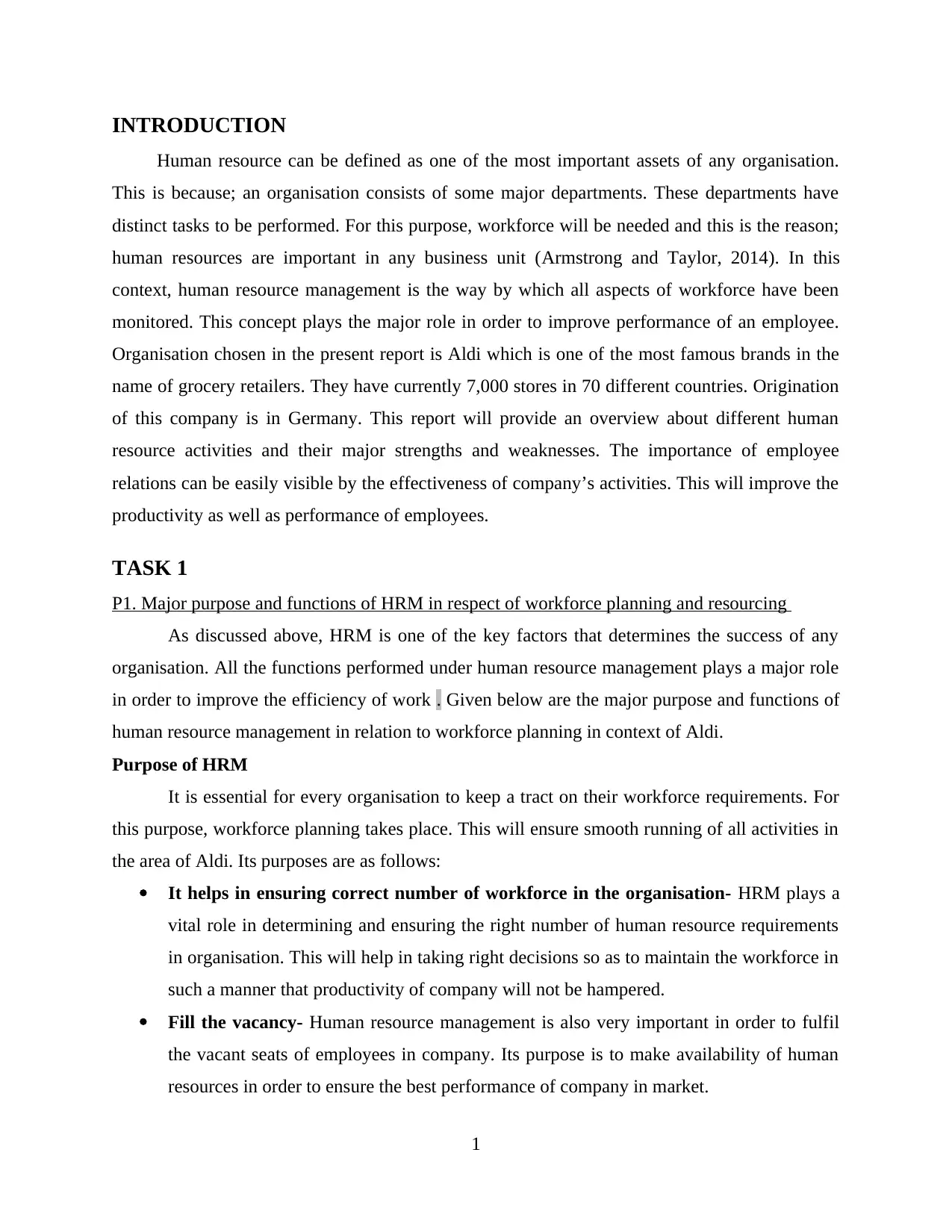
INTRODUCTION
Human resource can be defined as one of the most important assets of any organisation.
This is because; an organisation consists of some major departments. These departments have
distinct tasks to be performed. For this purpose, workforce will be needed and this is the reason;
human resources are important in any business unit (Armstrong and Taylor, 2014). In this
context, human resource management is the way by which all aspects of workforce have been
monitored. This concept plays the major role in order to improve performance of an employee.
Organisation chosen in the present report is Aldi which is one of the most famous brands in the
name of grocery retailers. They have currently 7,000 stores in 70 different countries. Origination
of this company is in Germany. This report will provide an overview about different human
resource activities and their major strengths and weaknesses. The importance of employee
relations can be easily visible by the effectiveness of company’s activities. This will improve the
productivity as well as performance of employees.
TASK 1
P1. Major purpose and functions of HRM in respect of workforce planning and resourcing
As discussed above, HRM is one of the key factors that determines the success of any
organisation. All the functions performed under human resource management plays a major role
in order to improve the efficiency of work . Given below are the major purpose and functions of
human resource management in relation to workforce planning in context of Aldi.
Purpose of HRM
It is essential for every organisation to keep a tract on their workforce requirements. For
this purpose, workforce planning takes place. This will ensure smooth running of all activities in
the area of Aldi. Its purposes are as follows:
It helps in ensuring correct number of workforce in the organisation- HRM plays a
vital role in determining and ensuring the right number of human resource requirements
in organisation. This will help in taking right decisions so as to maintain the workforce in
such a manner that productivity of company will not be hampered.
Fill the vacancy- Human resource management is also very important in order to fulfil
the vacant seats of employees in company. Its purpose is to make availability of human
resources in order to ensure the best performance of company in market.
1
Human resource can be defined as one of the most important assets of any organisation.
This is because; an organisation consists of some major departments. These departments have
distinct tasks to be performed. For this purpose, workforce will be needed and this is the reason;
human resources are important in any business unit (Armstrong and Taylor, 2014). In this
context, human resource management is the way by which all aspects of workforce have been
monitored. This concept plays the major role in order to improve performance of an employee.
Organisation chosen in the present report is Aldi which is one of the most famous brands in the
name of grocery retailers. They have currently 7,000 stores in 70 different countries. Origination
of this company is in Germany. This report will provide an overview about different human
resource activities and their major strengths and weaknesses. The importance of employee
relations can be easily visible by the effectiveness of company’s activities. This will improve the
productivity as well as performance of employees.
TASK 1
P1. Major purpose and functions of HRM in respect of workforce planning and resourcing
As discussed above, HRM is one of the key factors that determines the success of any
organisation. All the functions performed under human resource management plays a major role
in order to improve the efficiency of work . Given below are the major purpose and functions of
human resource management in relation to workforce planning in context of Aldi.
Purpose of HRM
It is essential for every organisation to keep a tract on their workforce requirements. For
this purpose, workforce planning takes place. This will ensure smooth running of all activities in
the area of Aldi. Its purposes are as follows:
It helps in ensuring correct number of workforce in the organisation- HRM plays a
vital role in determining and ensuring the right number of human resource requirements
in organisation. This will help in taking right decisions so as to maintain the workforce in
such a manner that productivity of company will not be hampered.
Fill the vacancy- Human resource management is also very important in order to fulfil
the vacant seats of employees in company. Its purpose is to make availability of human
resources in order to ensure the best performance of company in market.
1
⊘ This is a preview!⊘
Do you want full access?
Subscribe today to unlock all pages.

Trusted by 1+ million students worldwide
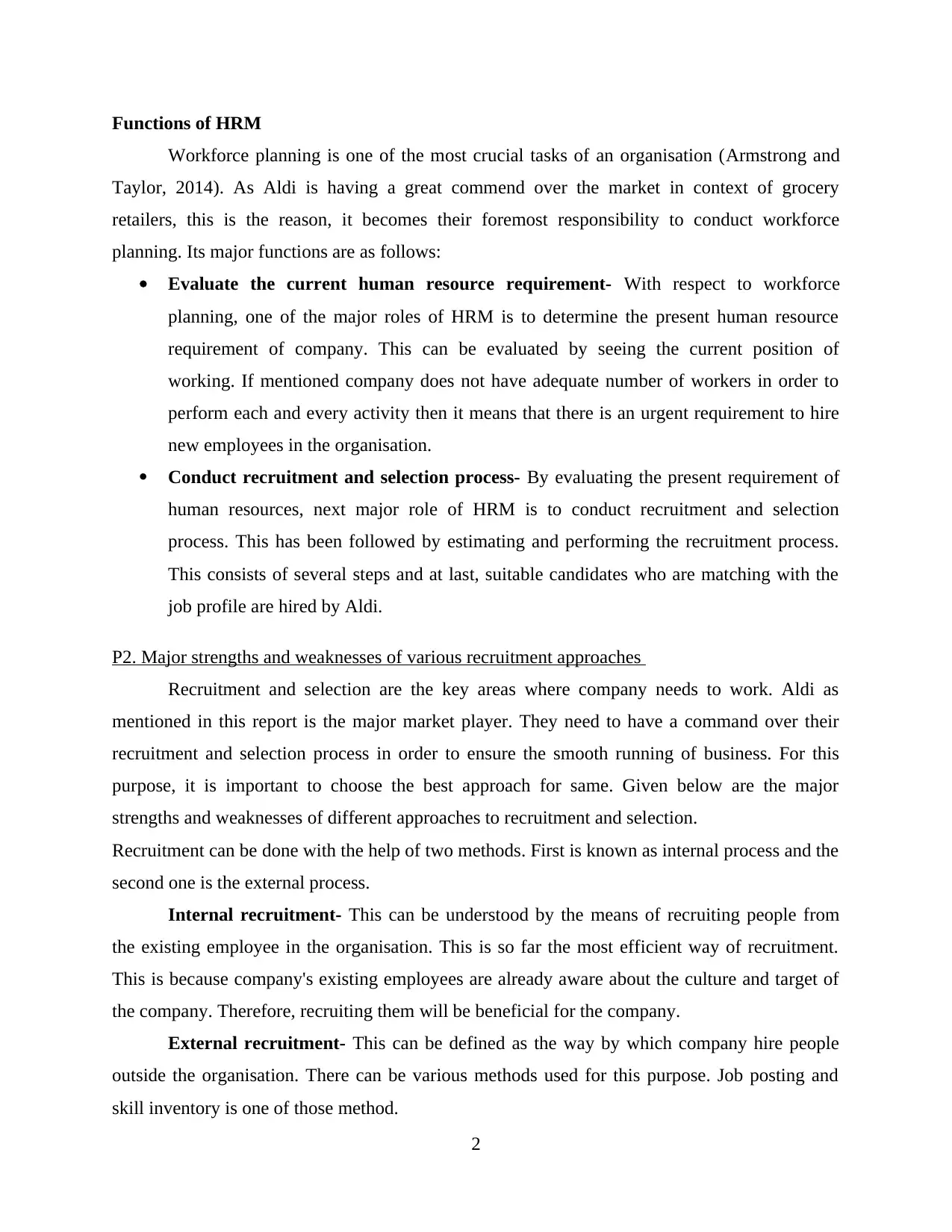
Functions of HRM
Workforce planning is one of the most crucial tasks of an organisation (Armstrong and
Taylor, 2014). As Aldi is having a great commend over the market in context of grocery
retailers, this is the reason, it becomes their foremost responsibility to conduct workforce
planning. Its major functions are as follows:
Evaluate the current human resource requirement- With respect to workforce
planning, one of the major roles of HRM is to determine the present human resource
requirement of company. This can be evaluated by seeing the current position of
working. If mentioned company does not have adequate number of workers in order to
perform each and every activity then it means that there is an urgent requirement to hire
new employees in the organisation.
Conduct recruitment and selection process- By evaluating the present requirement of
human resources, next major role of HRM is to conduct recruitment and selection
process. This has been followed by estimating and performing the recruitment process.
This consists of several steps and at last, suitable candidates who are matching with the
job profile are hired by Aldi.
P2. Major strengths and weaknesses of various recruitment approaches
Recruitment and selection are the key areas where company needs to work. Aldi as
mentioned in this report is the major market player. They need to have a command over their
recruitment and selection process in order to ensure the smooth running of business. For this
purpose, it is important to choose the best approach for same. Given below are the major
strengths and weaknesses of different approaches to recruitment and selection.
Recruitment can be done with the help of two methods. First is known as internal process and the
second one is the external process.
Internal recruitment- This can be understood by the means of recruiting people from
the existing employee in the organisation. This is so far the most efficient way of recruitment.
This is because company's existing employees are already aware about the culture and target of
the company. Therefore, recruiting them will be beneficial for the company.
External recruitment- This can be defined as the way by which company hire people
outside the organisation. There can be various methods used for this purpose. Job posting and
skill inventory is one of those method.
2
Workforce planning is one of the most crucial tasks of an organisation (Armstrong and
Taylor, 2014). As Aldi is having a great commend over the market in context of grocery
retailers, this is the reason, it becomes their foremost responsibility to conduct workforce
planning. Its major functions are as follows:
Evaluate the current human resource requirement- With respect to workforce
planning, one of the major roles of HRM is to determine the present human resource
requirement of company. This can be evaluated by seeing the current position of
working. If mentioned company does not have adequate number of workers in order to
perform each and every activity then it means that there is an urgent requirement to hire
new employees in the organisation.
Conduct recruitment and selection process- By evaluating the present requirement of
human resources, next major role of HRM is to conduct recruitment and selection
process. This has been followed by estimating and performing the recruitment process.
This consists of several steps and at last, suitable candidates who are matching with the
job profile are hired by Aldi.
P2. Major strengths and weaknesses of various recruitment approaches
Recruitment and selection are the key areas where company needs to work. Aldi as
mentioned in this report is the major market player. They need to have a command over their
recruitment and selection process in order to ensure the smooth running of business. For this
purpose, it is important to choose the best approach for same. Given below are the major
strengths and weaknesses of different approaches to recruitment and selection.
Recruitment can be done with the help of two methods. First is known as internal process and the
second one is the external process.
Internal recruitment- This can be understood by the means of recruiting people from
the existing employee in the organisation. This is so far the most efficient way of recruitment.
This is because company's existing employees are already aware about the culture and target of
the company. Therefore, recruiting them will be beneficial for the company.
External recruitment- This can be defined as the way by which company hire people
outside the organisation. There can be various methods used for this purpose. Job posting and
skill inventory is one of those method.
2
Paraphrase This Document
Need a fresh take? Get an instant paraphrase of this document with our AI Paraphraser
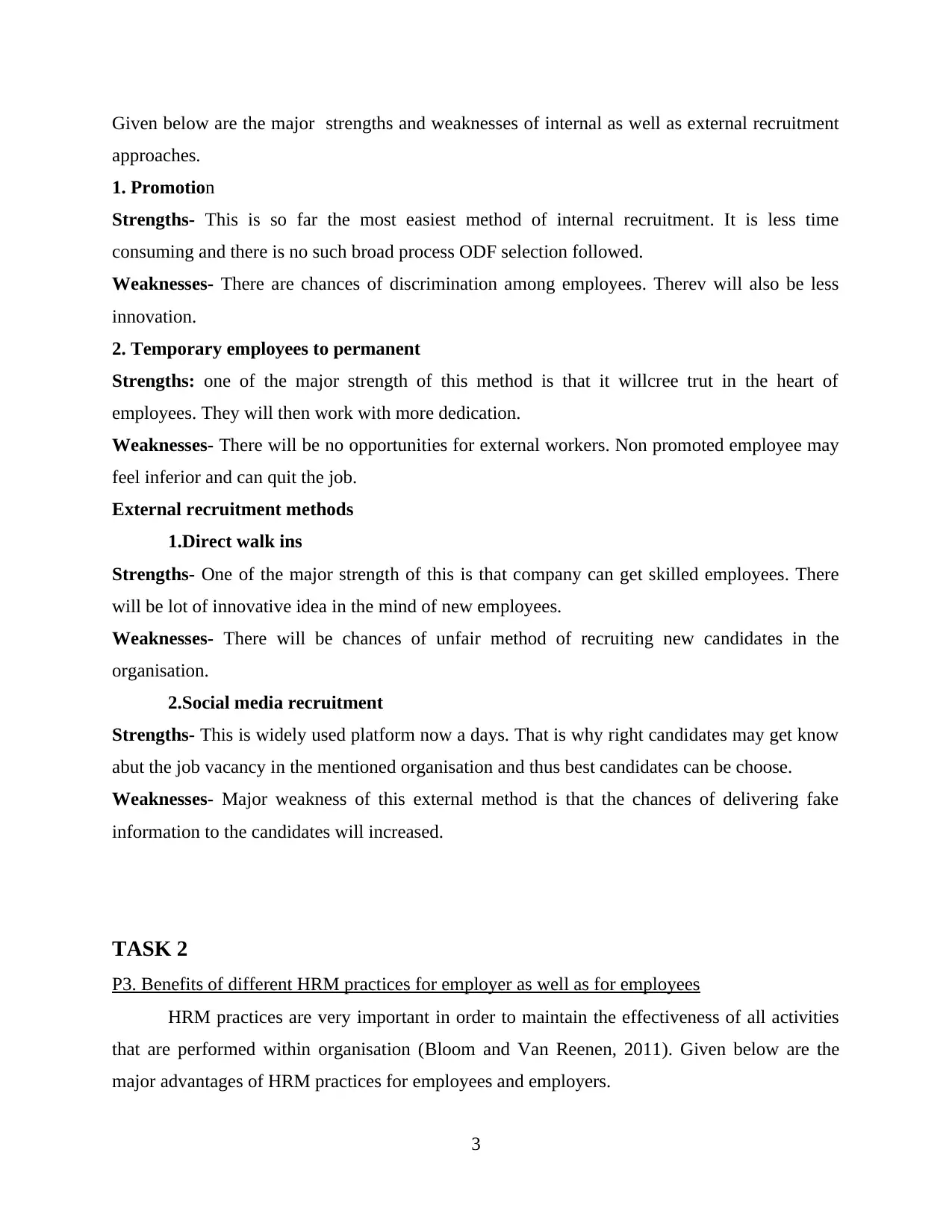
Given below are the major strengths and weaknesses of internal as well as external recruitment
approaches.
1. Promotion
Strengths- This is so far the most easiest method of internal recruitment. It is less time
consuming and there is no such broad process ODF selection followed.
Weaknesses- There are chances of discrimination among employees. Therev will also be less
innovation.
2. Temporary employees to permanent
Strengths: one of the major strength of this method is that it willcree trut in the heart of
employees. They will then work with more dedication.
Weaknesses- There will be no opportunities for external workers. Non promoted employee may
feel inferior and can quit the job.
External recruitment methods
1.Direct walk ins
Strengths- One of the major strength of this is that company can get skilled employees. There
will be lot of innovative idea in the mind of new employees.
Weaknesses- There will be chances of unfair method of recruiting new candidates in the
organisation.
2.Social media recruitment
Strengths- This is widely used platform now a days. That is why right candidates may get know
abut the job vacancy in the mentioned organisation and thus best candidates can be choose.
Weaknesses- Major weakness of this external method is that the chances of delivering fake
information to the candidates will increased.
TASK 2
P3. Benefits of different HRM practices for employer as well as for employees
HRM practices are very important in order to maintain the effectiveness of all activities
that are performed within organisation (Bloom and Van Reenen, 2011). Given below are the
major advantages of HRM practices for employees and employers.
3
approaches.
1. Promotion
Strengths- This is so far the most easiest method of internal recruitment. It is less time
consuming and there is no such broad process ODF selection followed.
Weaknesses- There are chances of discrimination among employees. Therev will also be less
innovation.
2. Temporary employees to permanent
Strengths: one of the major strength of this method is that it willcree trut in the heart of
employees. They will then work with more dedication.
Weaknesses- There will be no opportunities for external workers. Non promoted employee may
feel inferior and can quit the job.
External recruitment methods
1.Direct walk ins
Strengths- One of the major strength of this is that company can get skilled employees. There
will be lot of innovative idea in the mind of new employees.
Weaknesses- There will be chances of unfair method of recruiting new candidates in the
organisation.
2.Social media recruitment
Strengths- This is widely used platform now a days. That is why right candidates may get know
abut the job vacancy in the mentioned organisation and thus best candidates can be choose.
Weaknesses- Major weakness of this external method is that the chances of delivering fake
information to the candidates will increased.
TASK 2
P3. Benefits of different HRM practices for employer as well as for employees
HRM practices are very important in order to maintain the effectiveness of all activities
that are performed within organisation (Bloom and Van Reenen, 2011). Given below are the
major advantages of HRM practices for employees and employers.
3
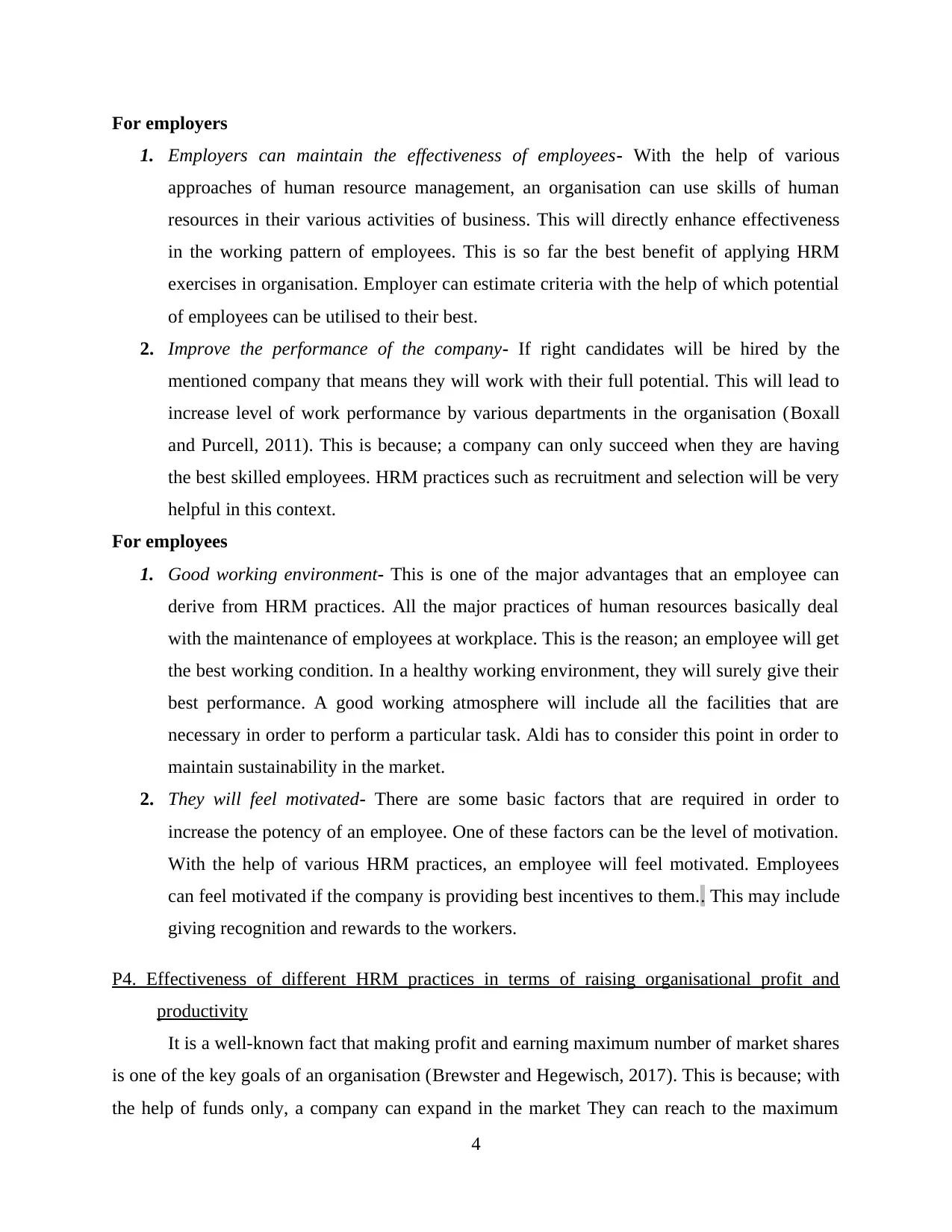
For employers
1. Employers can maintain the effectiveness of employees- With the help of various
approaches of human resource management, an organisation can use skills of human
resources in their various activities of business. This will directly enhance effectiveness
in the working pattern of employees. This is so far the best benefit of applying HRM
exercises in organisation. Employer can estimate criteria with the help of which potential
of employees can be utilised to their best.
2. Improve the performance of the company- If right candidates will be hired by the
mentioned company that means they will work with their full potential. This will lead to
increase level of work performance by various departments in the organisation (Boxall
and Purcell, 2011). This is because; a company can only succeed when they are having
the best skilled employees. HRM practices such as recruitment and selection will be very
helpful in this context.
For employees
1. Good working environment- This is one of the major advantages that an employee can
derive from HRM practices. All the major practices of human resources basically deal
with the maintenance of employees at workplace. This is the reason; an employee will get
the best working condition. In a healthy working environment, they will surely give their
best performance. A good working atmosphere will include all the facilities that are
necessary in order to perform a particular task. Aldi has to consider this point in order to
maintain sustainability in the market.
2. They will feel motivated- There are some basic factors that are required in order to
increase the potency of an employee. One of these factors can be the level of motivation.
With the help of various HRM practices, an employee will feel motivated. Employees
can feel motivated if the company is providing best incentives to them.. This may include
giving recognition and rewards to the workers.
P4. Effectiveness of different HRM practices in terms of raising organisational profit and
productivity
It is a well-known fact that making profit and earning maximum number of market shares
is one of the key goals of an organisation (Brewster and Hegewisch, 2017). This is because; with
the help of funds only, a company can expand in the market They can reach to the maximum
4
1. Employers can maintain the effectiveness of employees- With the help of various
approaches of human resource management, an organisation can use skills of human
resources in their various activities of business. This will directly enhance effectiveness
in the working pattern of employees. This is so far the best benefit of applying HRM
exercises in organisation. Employer can estimate criteria with the help of which potential
of employees can be utilised to their best.
2. Improve the performance of the company- If right candidates will be hired by the
mentioned company that means they will work with their full potential. This will lead to
increase level of work performance by various departments in the organisation (Boxall
and Purcell, 2011). This is because; a company can only succeed when they are having
the best skilled employees. HRM practices such as recruitment and selection will be very
helpful in this context.
For employees
1. Good working environment- This is one of the major advantages that an employee can
derive from HRM practices. All the major practices of human resources basically deal
with the maintenance of employees at workplace. This is the reason; an employee will get
the best working condition. In a healthy working environment, they will surely give their
best performance. A good working atmosphere will include all the facilities that are
necessary in order to perform a particular task. Aldi has to consider this point in order to
maintain sustainability in the market.
2. They will feel motivated- There are some basic factors that are required in order to
increase the potency of an employee. One of these factors can be the level of motivation.
With the help of various HRM practices, an employee will feel motivated. Employees
can feel motivated if the company is providing best incentives to them.. This may include
giving recognition and rewards to the workers.
P4. Effectiveness of different HRM practices in terms of raising organisational profit and
productivity
It is a well-known fact that making profit and earning maximum number of market shares
is one of the key goals of an organisation (Brewster and Hegewisch, 2017). This is because; with
the help of funds only, a company can expand in the market They can reach to the maximum
4
⊘ This is a preview!⊘
Do you want full access?
Subscribe today to unlock all pages.

Trusted by 1+ million students worldwide
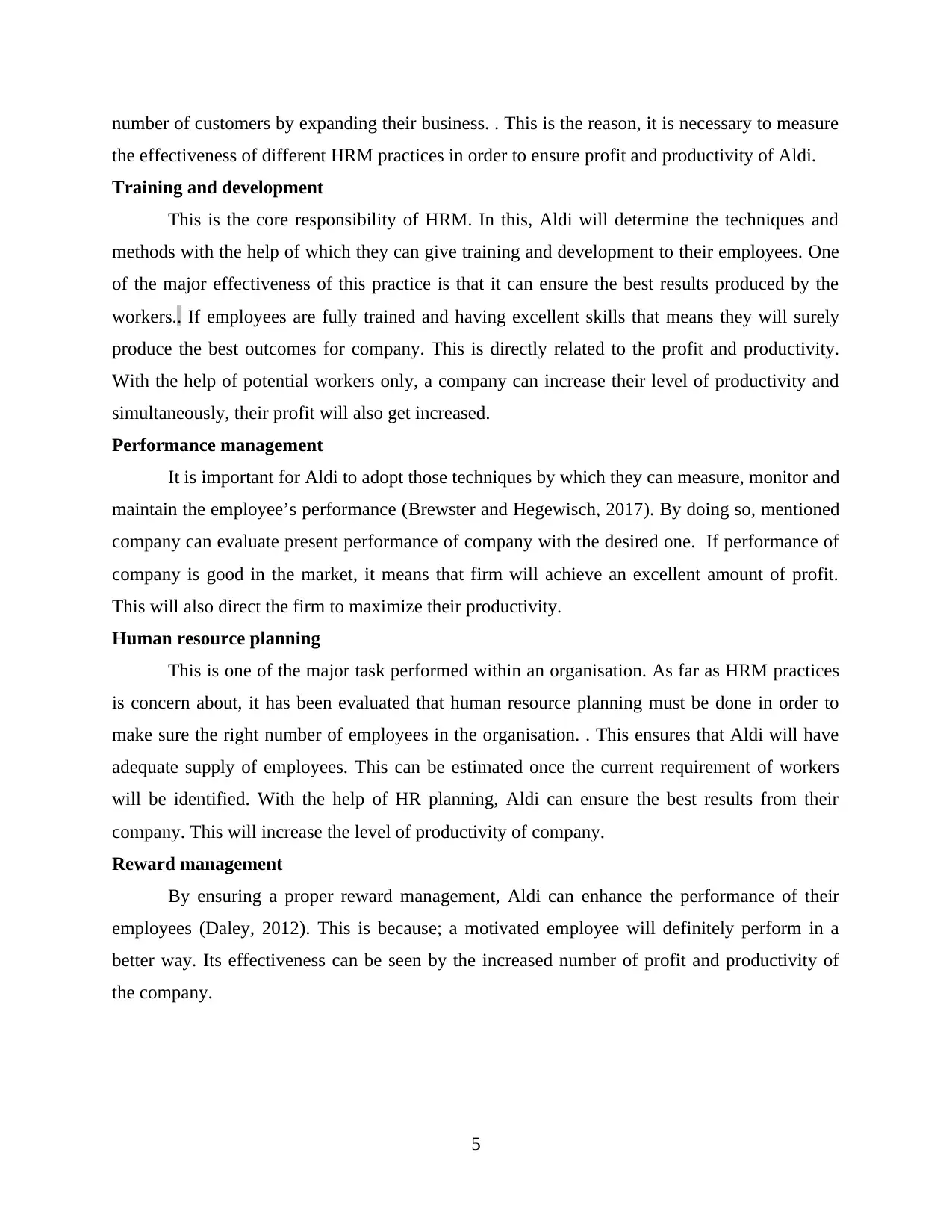
number of customers by expanding their business. . This is the reason, it is necessary to measure
the effectiveness of different HRM practices in order to ensure profit and productivity of Aldi.
Training and development
This is the core responsibility of HRM. In this, Aldi will determine the techniques and
methods with the help of which they can give training and development to their employees. One
of the major effectiveness of this practice is that it can ensure the best results produced by the
workers.. If employees are fully trained and having excellent skills that means they will surely
produce the best outcomes for company. This is directly related to the profit and productivity.
With the help of potential workers only, a company can increase their level of productivity and
simultaneously, their profit will also get increased.
Performance management
It is important for Aldi to adopt those techniques by which they can measure, monitor and
maintain the employee’s performance (Brewster and Hegewisch, 2017). By doing so, mentioned
company can evaluate present performance of company with the desired one. If performance of
company is good in the market, it means that firm will achieve an excellent amount of profit.
This will also direct the firm to maximize their productivity.
Human resource planning
This is one of the major task performed within an organisation. As far as HRM practices
is concern about, it has been evaluated that human resource planning must be done in order to
make sure the right number of employees in the organisation. . This ensures that Aldi will have
adequate supply of employees. This can be estimated once the current requirement of workers
will be identified. With the help of HR planning, Aldi can ensure the best results from their
company. This will increase the level of productivity of company.
Reward management
By ensuring a proper reward management, Aldi can enhance the performance of their
employees (Daley, 2012). This is because; a motivated employee will definitely perform in a
better way. Its effectiveness can be seen by the increased number of profit and productivity of
the company.
5
the effectiveness of different HRM practices in order to ensure profit and productivity of Aldi.
Training and development
This is the core responsibility of HRM. In this, Aldi will determine the techniques and
methods with the help of which they can give training and development to their employees. One
of the major effectiveness of this practice is that it can ensure the best results produced by the
workers.. If employees are fully trained and having excellent skills that means they will surely
produce the best outcomes for company. This is directly related to the profit and productivity.
With the help of potential workers only, a company can increase their level of productivity and
simultaneously, their profit will also get increased.
Performance management
It is important for Aldi to adopt those techniques by which they can measure, monitor and
maintain the employee’s performance (Brewster and Hegewisch, 2017). By doing so, mentioned
company can evaluate present performance of company with the desired one. If performance of
company is good in the market, it means that firm will achieve an excellent amount of profit.
This will also direct the firm to maximize their productivity.
Human resource planning
This is one of the major task performed within an organisation. As far as HRM practices
is concern about, it has been evaluated that human resource planning must be done in order to
make sure the right number of employees in the organisation. . This ensures that Aldi will have
adequate supply of employees. This can be estimated once the current requirement of workers
will be identified. With the help of HR planning, Aldi can ensure the best results from their
company. This will increase the level of productivity of company.
Reward management
By ensuring a proper reward management, Aldi can enhance the performance of their
employees (Daley, 2012). This is because; a motivated employee will definitely perform in a
better way. Its effectiveness can be seen by the increased number of profit and productivity of
the company.
5
Paraphrase This Document
Need a fresh take? Get an instant paraphrase of this document with our AI Paraphraser
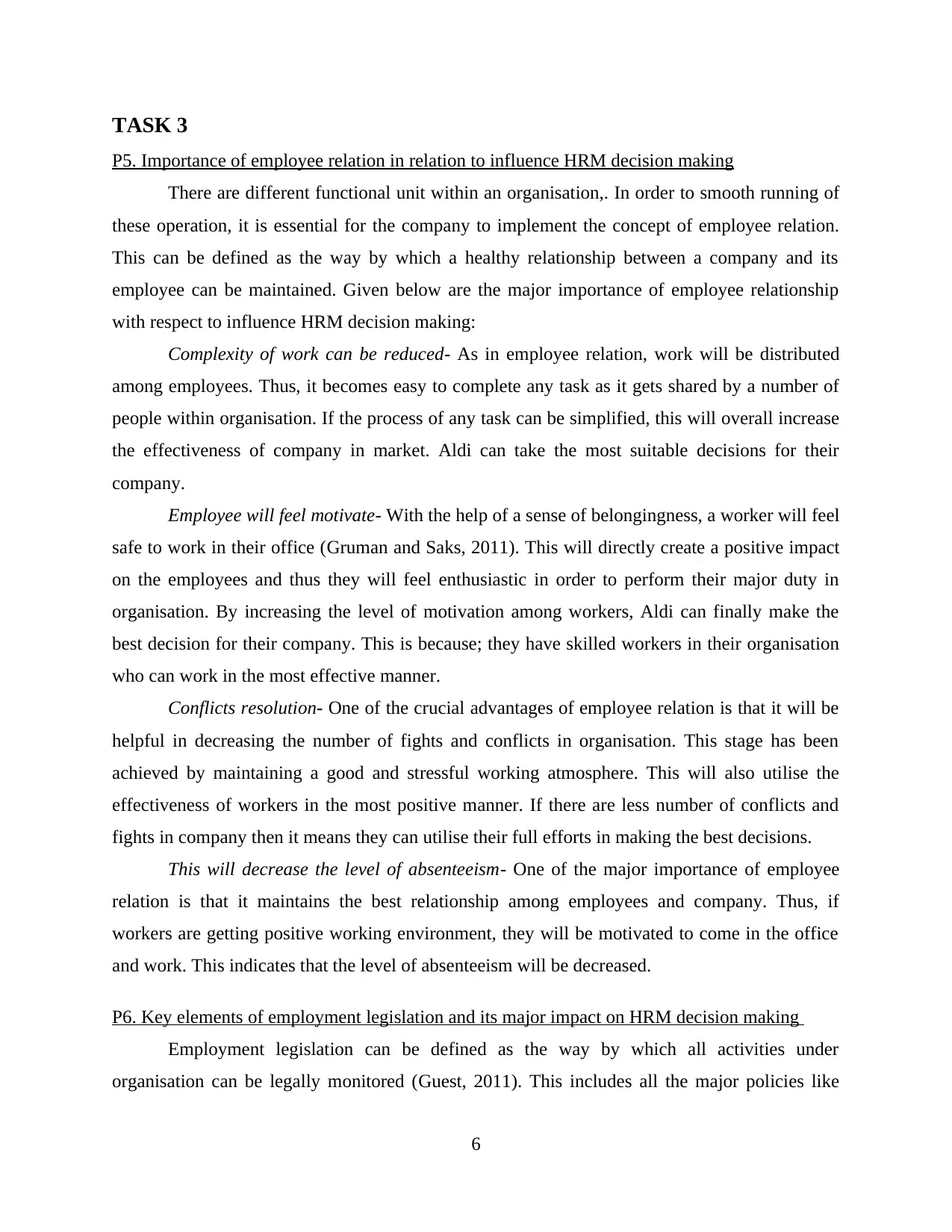
TASK 3
P5. Importance of employee relation in relation to influence HRM decision making
There are different functional unit within an organisation,. In order to smooth running of
these operation, it is essential for the company to implement the concept of employee relation.
This can be defined as the way by which a healthy relationship between a company and its
employee can be maintained. Given below are the major importance of employee relationship
with respect to influence HRM decision making:
Complexity of work can be reduced- As in employee relation, work will be distributed
among employees. Thus, it becomes easy to complete any task as it gets shared by a number of
people within organisation. If the process of any task can be simplified, this will overall increase
the effectiveness of company in market. Aldi can take the most suitable decisions for their
company.
Employee will feel motivate- With the help of a sense of belongingness, a worker will feel
safe to work in their office (Gruman and Saks, 2011). This will directly create a positive impact
on the employees and thus they will feel enthusiastic in order to perform their major duty in
organisation. By increasing the level of motivation among workers, Aldi can finally make the
best decision for their company. This is because; they have skilled workers in their organisation
who can work in the most effective manner.
Conflicts resolution- One of the crucial advantages of employee relation is that it will be
helpful in decreasing the number of fights and conflicts in organisation. This stage has been
achieved by maintaining a good and stressful working atmosphere. This will also utilise the
effectiveness of workers in the most positive manner. If there are less number of conflicts and
fights in company then it means they can utilise their full efforts in making the best decisions.
This will decrease the level of absenteeism- One of the major importance of employee
relation is that it maintains the best relationship among employees and company. Thus, if
workers are getting positive working environment, they will be motivated to come in the office
and work. This indicates that the level of absenteeism will be decreased.
P6. Key elements of employment legislation and its major impact on HRM decision making
Employment legislation can be defined as the way by which all activities under
organisation can be legally monitored (Guest, 2011). This includes all the major policies like
6
P5. Importance of employee relation in relation to influence HRM decision making
There are different functional unit within an organisation,. In order to smooth running of
these operation, it is essential for the company to implement the concept of employee relation.
This can be defined as the way by which a healthy relationship between a company and its
employee can be maintained. Given below are the major importance of employee relationship
with respect to influence HRM decision making:
Complexity of work can be reduced- As in employee relation, work will be distributed
among employees. Thus, it becomes easy to complete any task as it gets shared by a number of
people within organisation. If the process of any task can be simplified, this will overall increase
the effectiveness of company in market. Aldi can take the most suitable decisions for their
company.
Employee will feel motivate- With the help of a sense of belongingness, a worker will feel
safe to work in their office (Gruman and Saks, 2011). This will directly create a positive impact
on the employees and thus they will feel enthusiastic in order to perform their major duty in
organisation. By increasing the level of motivation among workers, Aldi can finally make the
best decision for their company. This is because; they have skilled workers in their organisation
who can work in the most effective manner.
Conflicts resolution- One of the crucial advantages of employee relation is that it will be
helpful in decreasing the number of fights and conflicts in organisation. This stage has been
achieved by maintaining a good and stressful working atmosphere. This will also utilise the
effectiveness of workers in the most positive manner. If there are less number of conflicts and
fights in company then it means they can utilise their full efforts in making the best decisions.
This will decrease the level of absenteeism- One of the major importance of employee
relation is that it maintains the best relationship among employees and company. Thus, if
workers are getting positive working environment, they will be motivated to come in the office
and work. This indicates that the level of absenteeism will be decreased.
P6. Key elements of employment legislation and its major impact on HRM decision making
Employment legislation can be defined as the way by which all activities under
organisation can be legally monitored (Guest, 2011). This includes all the major policies like
6
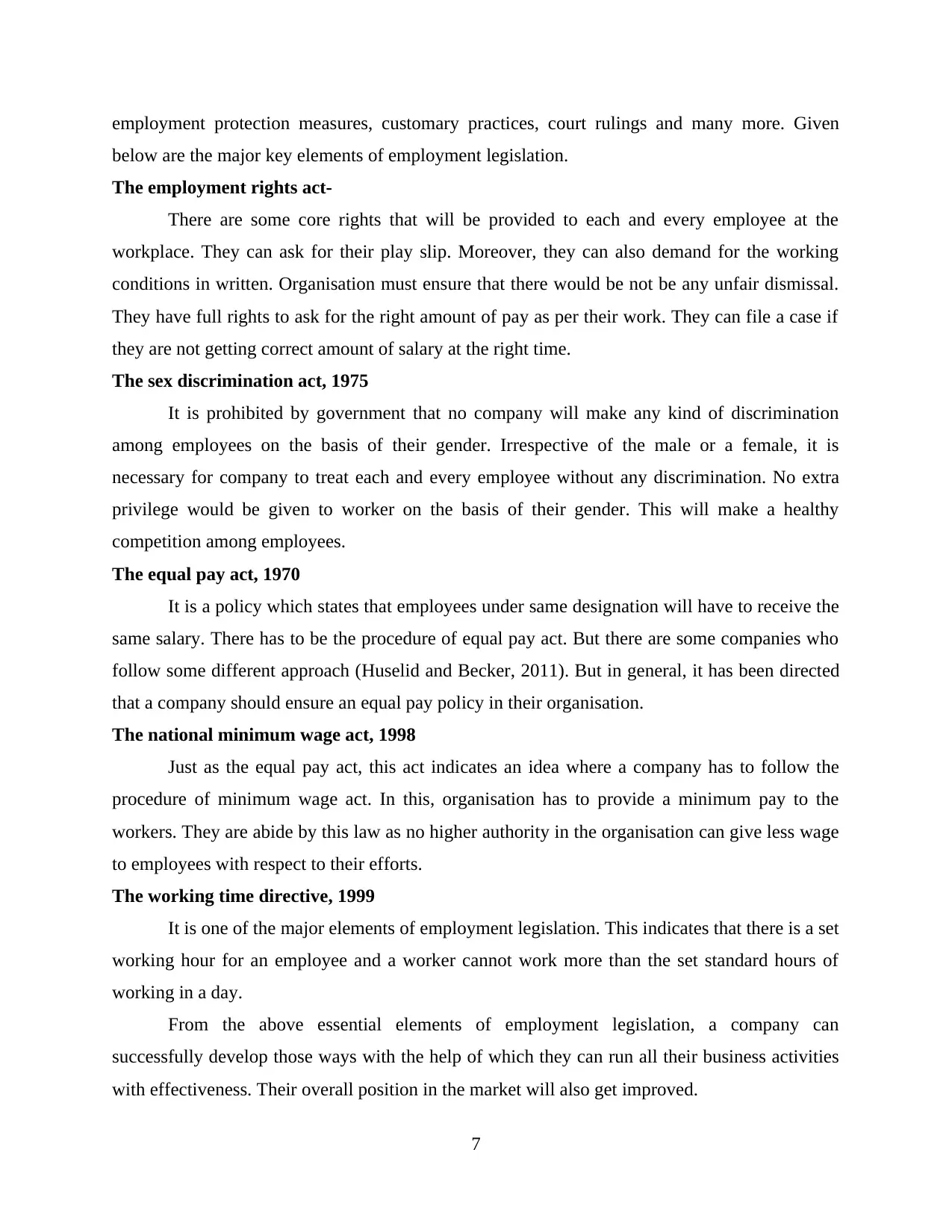
employment protection measures, customary practices, court rulings and many more. Given
below are the major key elements of employment legislation.
The employment rights act-
There are some core rights that will be provided to each and every employee at the
workplace. They can ask for their play slip. Moreover, they can also demand for the working
conditions in written. Organisation must ensure that there would be not be any unfair dismissal.
They have full rights to ask for the right amount of pay as per their work. They can file a case if
they are not getting correct amount of salary at the right time.
The sex discrimination act, 1975
It is prohibited by government that no company will make any kind of discrimination
among employees on the basis of their gender. Irrespective of the male or a female, it is
necessary for company to treat each and every employee without any discrimination. No extra
privilege would be given to worker on the basis of their gender. This will make a healthy
competition among employees.
The equal pay act, 1970
It is a policy which states that employees under same designation will have to receive the
same salary. There has to be the procedure of equal pay act. But there are some companies who
follow some different approach (Huselid and Becker, 2011). But in general, it has been directed
that a company should ensure an equal pay policy in their organisation.
The national minimum wage act, 1998
Just as the equal pay act, this act indicates an idea where a company has to follow the
procedure of minimum wage act. In this, organisation has to provide a minimum pay to the
workers. They are abide by this law as no higher authority in the organisation can give less wage
to employees with respect to their efforts.
The working time directive, 1999
It is one of the major elements of employment legislation. This indicates that there is a set
working hour for an employee and a worker cannot work more than the set standard hours of
working in a day.
From the above essential elements of employment legislation, a company can
successfully develop those ways with the help of which they can run all their business activities
with effectiveness. Their overall position in the market will also get improved.
7
below are the major key elements of employment legislation.
The employment rights act-
There are some core rights that will be provided to each and every employee at the
workplace. They can ask for their play slip. Moreover, they can also demand for the working
conditions in written. Organisation must ensure that there would be not be any unfair dismissal.
They have full rights to ask for the right amount of pay as per their work. They can file a case if
they are not getting correct amount of salary at the right time.
The sex discrimination act, 1975
It is prohibited by government that no company will make any kind of discrimination
among employees on the basis of their gender. Irrespective of the male or a female, it is
necessary for company to treat each and every employee without any discrimination. No extra
privilege would be given to worker on the basis of their gender. This will make a healthy
competition among employees.
The equal pay act, 1970
It is a policy which states that employees under same designation will have to receive the
same salary. There has to be the procedure of equal pay act. But there are some companies who
follow some different approach (Huselid and Becker, 2011). But in general, it has been directed
that a company should ensure an equal pay policy in their organisation.
The national minimum wage act, 1998
Just as the equal pay act, this act indicates an idea where a company has to follow the
procedure of minimum wage act. In this, organisation has to provide a minimum pay to the
workers. They are abide by this law as no higher authority in the organisation can give less wage
to employees with respect to their efforts.
The working time directive, 1999
It is one of the major elements of employment legislation. This indicates that there is a set
working hour for an employee and a worker cannot work more than the set standard hours of
working in a day.
From the above essential elements of employment legislation, a company can
successfully develop those ways with the help of which they can run all their business activities
with effectiveness. Their overall position in the market will also get improved.
7
⊘ This is a preview!⊘
Do you want full access?
Subscribe today to unlock all pages.

Trusted by 1+ million students worldwide
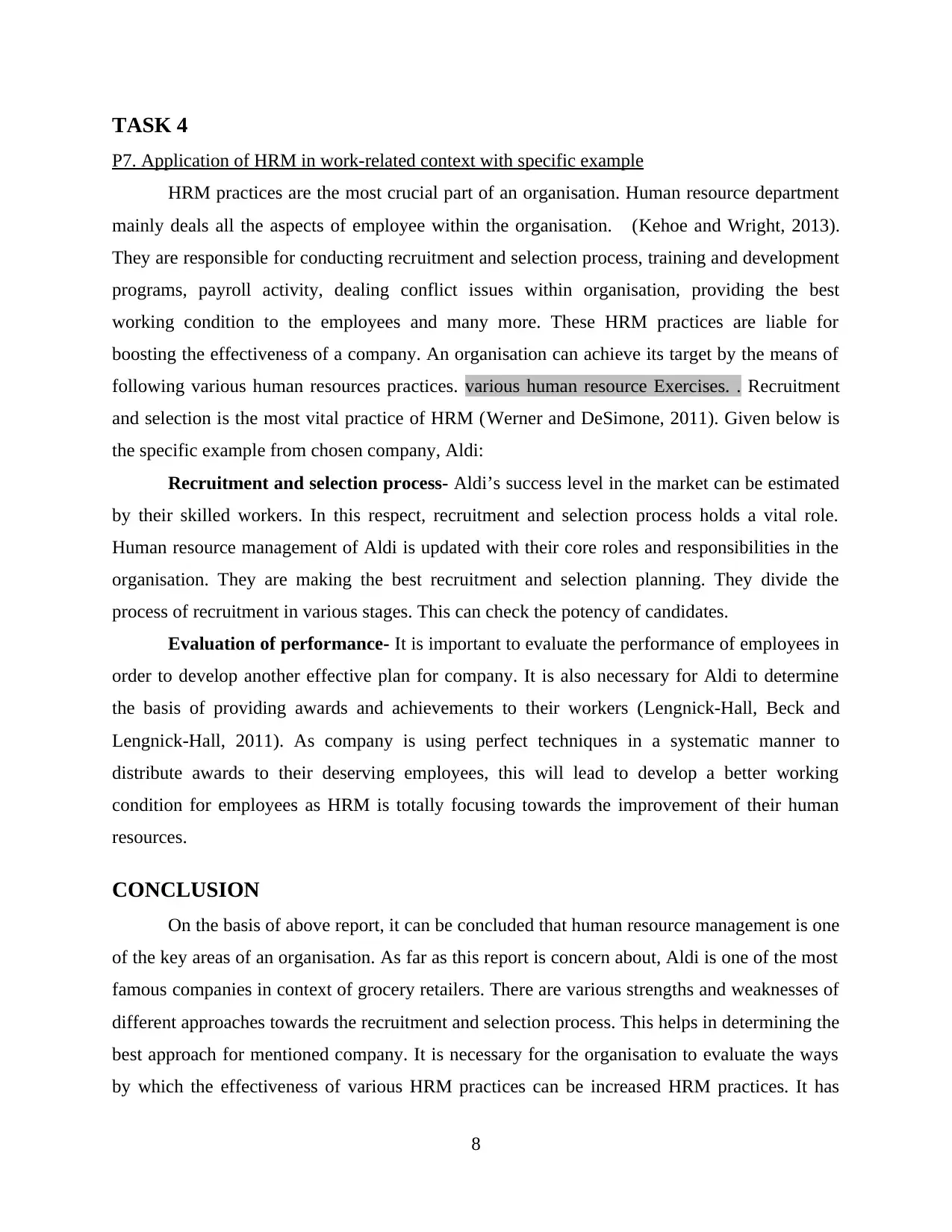
TASK 4
P7. Application of HRM in work-related context with specific example
HRM practices are the most crucial part of an organisation. Human resource department
mainly deals all the aspects of employee within the organisation. (Kehoe and Wright, 2013).
They are responsible for conducting recruitment and selection process, training and development
programs, payroll activity, dealing conflict issues within organisation, providing the best
working condition to the employees and many more. These HRM practices are liable for
boosting the effectiveness of a company. An organisation can achieve its target by the means of
following various human resources practices. various human resource Exercises. . Recruitment
and selection is the most vital practice of HRM (Werner and DeSimone, 2011). Given below is
the specific example from chosen company, Aldi:
Recruitment and selection process- Aldi’s success level in the market can be estimated
by their skilled workers. In this respect, recruitment and selection process holds a vital role.
Human resource management of Aldi is updated with their core roles and responsibilities in the
organisation. They are making the best recruitment and selection planning. They divide the
process of recruitment in various stages. This can check the potency of candidates.
Evaluation of performance- It is important to evaluate the performance of employees in
order to develop another effective plan for company. It is also necessary for Aldi to determine
the basis of providing awards and achievements to their workers (Lengnick-Hall, Beck and
Lengnick-Hall, 2011). As company is using perfect techniques in a systematic manner to
distribute awards to their deserving employees, this will lead to develop a better working
condition for employees as HRM is totally focusing towards the improvement of their human
resources.
CONCLUSION
On the basis of above report, it can be concluded that human resource management is one
of the key areas of an organisation. As far as this report is concern about, Aldi is one of the most
famous companies in context of grocery retailers. There are various strengths and weaknesses of
different approaches towards the recruitment and selection process. This helps in determining the
best approach for mentioned company. It is necessary for the organisation to evaluate the ways
by which the effectiveness of various HRM practices can be increased HRM practices. It has
8
P7. Application of HRM in work-related context with specific example
HRM practices are the most crucial part of an organisation. Human resource department
mainly deals all the aspects of employee within the organisation. (Kehoe and Wright, 2013).
They are responsible for conducting recruitment and selection process, training and development
programs, payroll activity, dealing conflict issues within organisation, providing the best
working condition to the employees and many more. These HRM practices are liable for
boosting the effectiveness of a company. An organisation can achieve its target by the means of
following various human resources practices. various human resource Exercises. . Recruitment
and selection is the most vital practice of HRM (Werner and DeSimone, 2011). Given below is
the specific example from chosen company, Aldi:
Recruitment and selection process- Aldi’s success level in the market can be estimated
by their skilled workers. In this respect, recruitment and selection process holds a vital role.
Human resource management of Aldi is updated with their core roles and responsibilities in the
organisation. They are making the best recruitment and selection planning. They divide the
process of recruitment in various stages. This can check the potency of candidates.
Evaluation of performance- It is important to evaluate the performance of employees in
order to develop another effective plan for company. It is also necessary for Aldi to determine
the basis of providing awards and achievements to their workers (Lengnick-Hall, Beck and
Lengnick-Hall, 2011). As company is using perfect techniques in a systematic manner to
distribute awards to their deserving employees, this will lead to develop a better working
condition for employees as HRM is totally focusing towards the improvement of their human
resources.
CONCLUSION
On the basis of above report, it can be concluded that human resource management is one
of the key areas of an organisation. As far as this report is concern about, Aldi is one of the most
famous companies in context of grocery retailers. There are various strengths and weaknesses of
different approaches towards the recruitment and selection process. This helps in determining the
best approach for mentioned company. It is necessary for the organisation to evaluate the ways
by which the effectiveness of various HRM practices can be increased HRM practices. It has
8
Paraphrase This Document
Need a fresh take? Get an instant paraphrase of this document with our AI Paraphraser
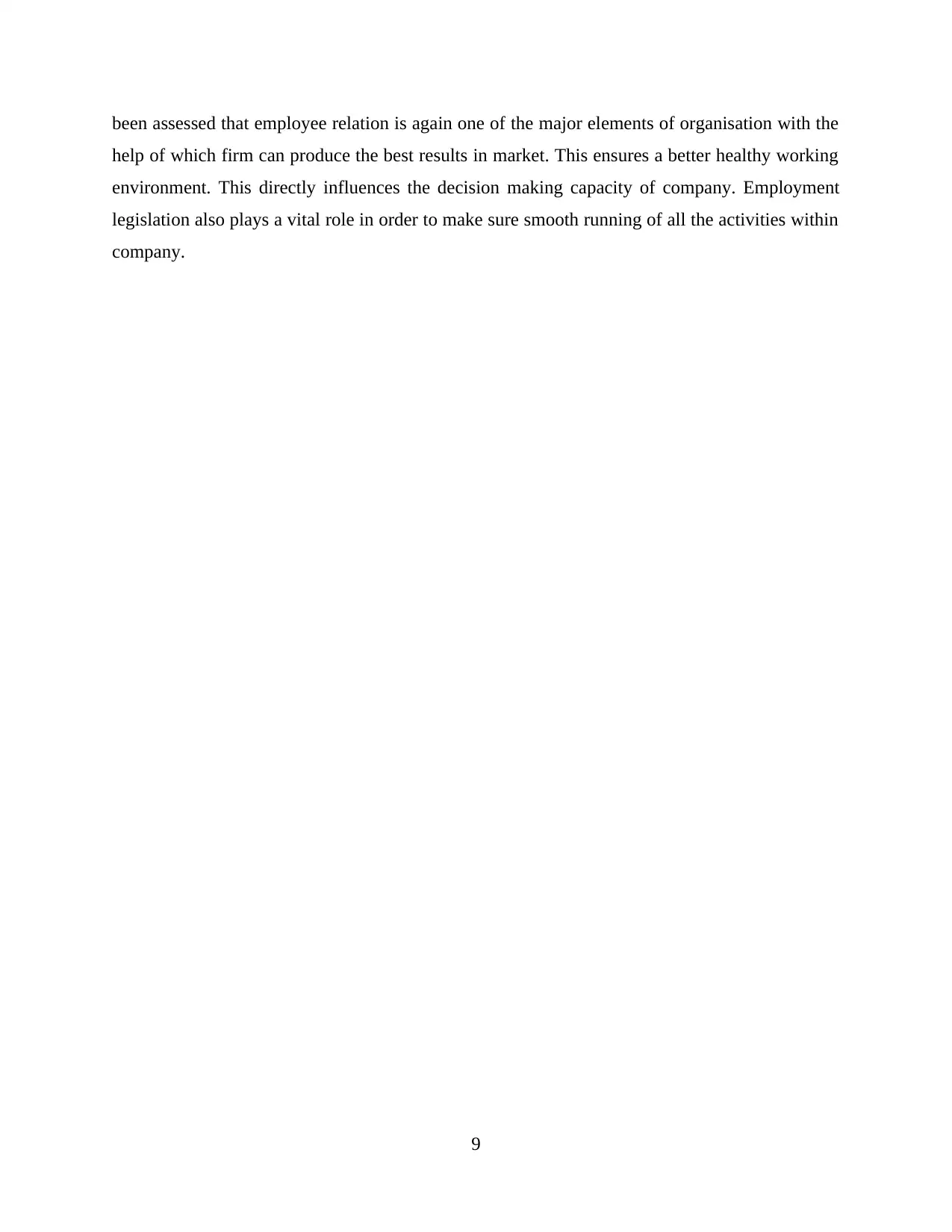
been assessed that employee relation is again one of the major elements of organisation with the
help of which firm can produce the best results in market. This ensures a better healthy working
environment. This directly influences the decision making capacity of company. Employment
legislation also plays a vital role in order to make sure smooth running of all the activities within
company.
9
help of which firm can produce the best results in market. This ensures a better healthy working
environment. This directly influences the decision making capacity of company. Employment
legislation also plays a vital role in order to make sure smooth running of all the activities within
company.
9
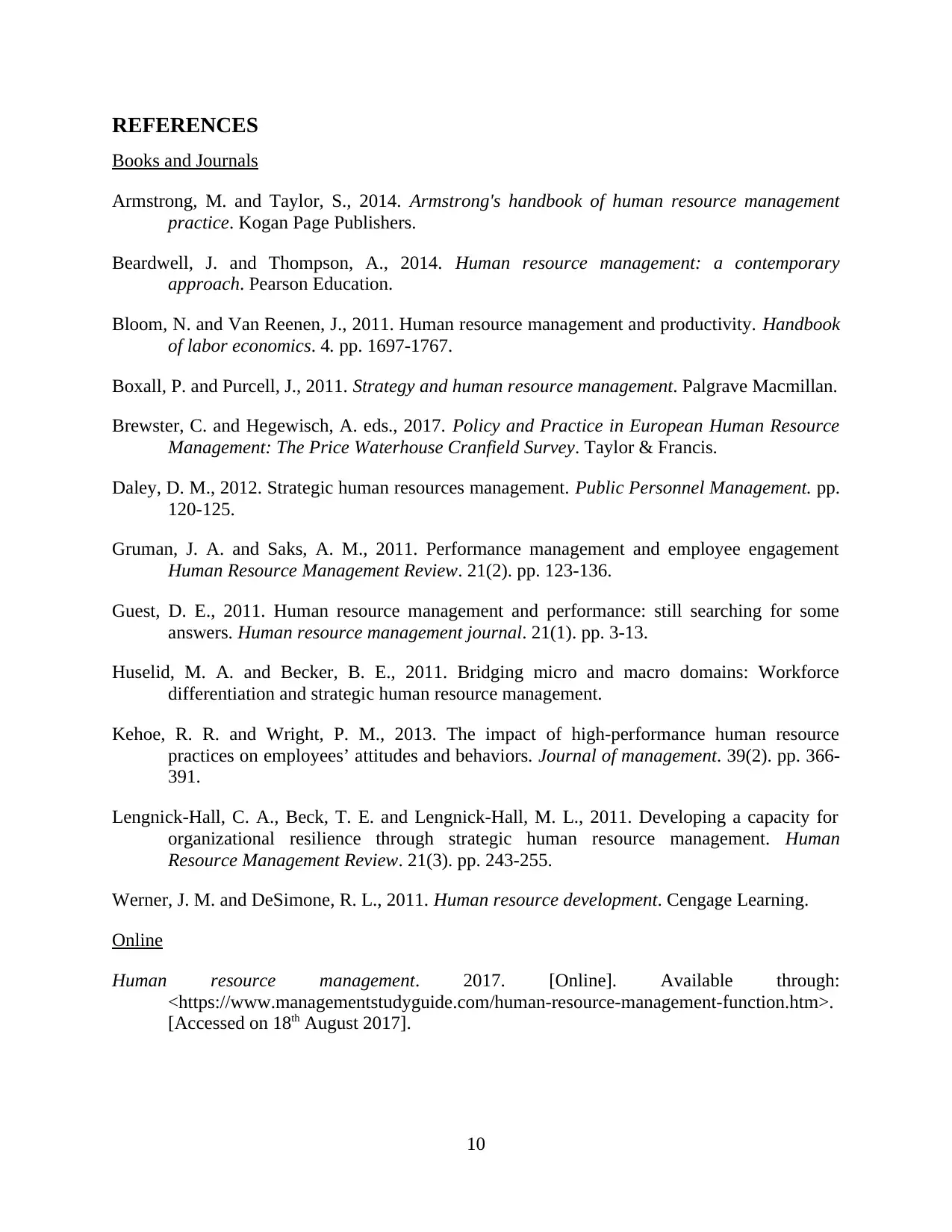
REFERENCES
Books and Journals
Armstrong, M. and Taylor, S., 2014. Armstrong's handbook of human resource management
practice. Kogan Page Publishers.
Beardwell, J. and Thompson, A., 2014. Human resource management: a contemporary
approach. Pearson Education.
Bloom, N. and Van Reenen, J., 2011. Human resource management and productivity. Handbook
of labor economics. 4. pp. 1697-1767.
Boxall, P. and Purcell, J., 2011. Strategy and human resource management. Palgrave Macmillan.
Brewster, C. and Hegewisch, A. eds., 2017. Policy and Practice in European Human Resource
Management: The Price Waterhouse Cranfield Survey. Taylor & Francis.
Daley, D. M., 2012. Strategic human resources management. Public Personnel Management. pp.
120-125.
Gruman, J. A. and Saks, A. M., 2011. Performance management and employee engagement
Human Resource Management Review. 21(2). pp. 123-136.
Guest, D. E., 2011. Human resource management and performance: still searching for some
answers. Human resource management journal. 21(1). pp. 3-13.
Huselid, M. A. and Becker, B. E., 2011. Bridging micro and macro domains: Workforce
differentiation and strategic human resource management.
Kehoe, R. R. and Wright, P. M., 2013. The impact of high-performance human resource
practices on employees’ attitudes and behaviors. Journal of management. 39(2). pp. 366-
391.
Lengnick-Hall, C. A., Beck, T. E. and Lengnick-Hall, M. L., 2011. Developing a capacity for
organizational resilience through strategic human resource management. Human
Resource Management Review. 21(3). pp. 243-255.
Werner, J. M. and DeSimone, R. L., 2011. Human resource development. Cengage Learning.
Online
Human resource management. 2017. [Online]. Available through:
<https://www.managementstudyguide.com/human-resource-management-function.htm>.
[Accessed on 18th August 2017].
10
Books and Journals
Armstrong, M. and Taylor, S., 2014. Armstrong's handbook of human resource management
practice. Kogan Page Publishers.
Beardwell, J. and Thompson, A., 2014. Human resource management: a contemporary
approach. Pearson Education.
Bloom, N. and Van Reenen, J., 2011. Human resource management and productivity. Handbook
of labor economics. 4. pp. 1697-1767.
Boxall, P. and Purcell, J., 2011. Strategy and human resource management. Palgrave Macmillan.
Brewster, C. and Hegewisch, A. eds., 2017. Policy and Practice in European Human Resource
Management: The Price Waterhouse Cranfield Survey. Taylor & Francis.
Daley, D. M., 2012. Strategic human resources management. Public Personnel Management. pp.
120-125.
Gruman, J. A. and Saks, A. M., 2011. Performance management and employee engagement
Human Resource Management Review. 21(2). pp. 123-136.
Guest, D. E., 2011. Human resource management and performance: still searching for some
answers. Human resource management journal. 21(1). pp. 3-13.
Huselid, M. A. and Becker, B. E., 2011. Bridging micro and macro domains: Workforce
differentiation and strategic human resource management.
Kehoe, R. R. and Wright, P. M., 2013. The impact of high-performance human resource
practices on employees’ attitudes and behaviors. Journal of management. 39(2). pp. 366-
391.
Lengnick-Hall, C. A., Beck, T. E. and Lengnick-Hall, M. L., 2011. Developing a capacity for
organizational resilience through strategic human resource management. Human
Resource Management Review. 21(3). pp. 243-255.
Werner, J. M. and DeSimone, R. L., 2011. Human resource development. Cengage Learning.
Online
Human resource management. 2017. [Online]. Available through:
<https://www.managementstudyguide.com/human-resource-management-function.htm>.
[Accessed on 18th August 2017].
10
⊘ This is a preview!⊘
Do you want full access?
Subscribe today to unlock all pages.

Trusted by 1+ million students worldwide
1 out of 12
Related Documents
Your All-in-One AI-Powered Toolkit for Academic Success.
+13062052269
info@desklib.com
Available 24*7 on WhatsApp / Email
![[object Object]](/_next/static/media/star-bottom.7253800d.svg)
Unlock your academic potential
Copyright © 2020–2025 A2Z Services. All Rights Reserved. Developed and managed by ZUCOL.





